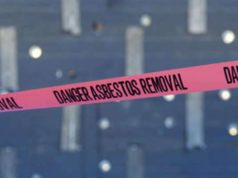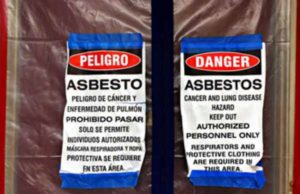
Following Florida asbestos abatement procedures is critical to avoid penalties assessed by the state government. The Florida Department of Environmental Protection regulates asbestos abatement by certifying contractors and consultants to identify and remove regulated asbestos containing materials.
How do I know if I have asbestos in my home?
Asbestos is generally invisible to the human eye, unless it existing in the home in a relatively unprocessed form. While most asbestos will be rendered into power and mixed into other applications, certain uses of asbestos, such as concrete roofing insulation, will contain entire chunks of the friable material. It is far more likely however, that chipping and crumbling plaster and joint compound are of a greater danger to the health of residents. Only an asbestos consultant or contractor certified by the state can identify asbestos properly and send bulk samples for testing. Laboratory testing can certify the presence of asbestos that the asbestos abatement professional will be able to recommend an appropriate course of action. Laboratory testing fees will be nominal and will not exceed $100.
Who may perform Florida asbestos abatement procedures?
The state of Florida certifies asbestos abatement contractors through a rigorous, four hour, two part test that checks the applicant’s knowledge of asbestos safety regulations, abatement procedure and general knowledge. Only after passing this test can an individual be certified to remove asbestos. Individual homeowners should not attempt asbestos removal as it is dangerous and you risk worsening contamination.
How does asbestos abatement proceed?
Friable materials are the biggest hazard for any asbestos abatement project. Any and all friable abatement will involve vacuuming any debris that may be present then waterlogging the asbestos material with a technique called “wetting.” Wetting prevents fibers from spreading in the air, as each asbestos fiber is comprised of many more fibers. The material will be sealed while wet and will be disposed of in a secure and labeled container at a landfill designated by the Florida DEP.
Encapsulation is an alternative to removal as this will seal all asbestos fibers behind a protective barrier. The fibers will not escape as long as the seal holds, so breaking or otherwise tampering with walls and ceilings after this procedure is not recommended.
Notification of asbestos abatement
The state must be notified any time you plan renovation or demolition. Generally, during renovation, you are only needed to remove friable materials and non-friable materials that may crumble or break during the renovation. All other non-exposed forms may remain in the structure. Demolition will require the entire building to be stripped of asbestos, including encapsulated asbestos before it may proceed. Those that need to notify the state, as per Florida asbestos abatement procedure must fill out the appropriate form and submit it ten working days before the project will begin. The form will ask about the procedure used to remove the RACM, the contact information of the contractor, the amount of RACM present and the location of the property. The permit is issued only after the notification document is certified and a permit is issued.





























